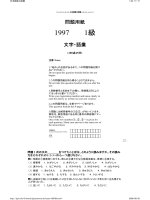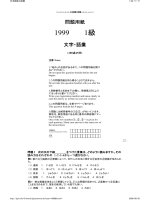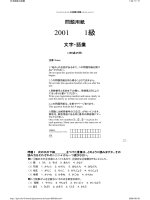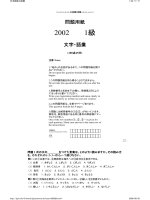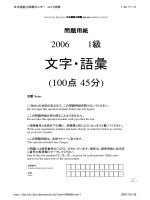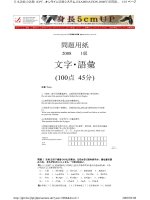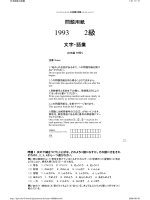ĐỀ án THIẾT kế ĐỊNH DẠNG đề THI NĂNG lực TIẾNG ANH
Bạn đang xem bản rút gọn của tài liệu. Xem và tải ngay bản đầy đủ của tài liệu tại đây (1.71 MB, 123 trang )
ĐẠI HỌC QUỐC GIA HÀ NỘI
TRƢỜNG ĐẠI HỌC NGOẠI NGỮ
-------------------------------------
ĐỀ ÁN THIẾT KẾ ĐỊNH DẠNG ĐỀ THI NĂNG LỰC TIẾNG ANH
TỪ BẬC 3 ĐẾN BẬC 5
CHO ĐỐI TƢỢNG SAU TRUNG HỌC PHỔ THÔNG
(VIETNAMESE STANDARDIZED TEST OF ENGLISH
PROFICIENCY - VSTEP)
CHỦ NHIỆM ĐỀ ÁN: GS. NGUYỄN HÒA
HÀ NỘI, THÁNG 12 NĂM 2014
MỤC LỤC
I. GIỚI THIỆU ĐỀ ÁN ....................................................................................................................... 1
II. CHI TIẾT VỀ BÀI THI.................................................................................................................. 3
II.1. Định dạng Đề thi Năng lực Tiếng Anh từ Bậc 3 đến Bậc 5 (Phiên bản công bố) ....... 3
II.2. Bảng quy đổi điểm thi ......................................................................................................... 5
II.3. Đề thi mẫu ............................................................................................................................. 6
III. QUY TRÌNH XÂY DỰNG ĐỊNH DẠNG BÀI THI ............................................................. 29
IV. QUY TRÌNH VÀ KẾT QUẢ XÁC TRỊ BÀI THI MẪU ...................................................... 38
V. TÀI LIỆU THAM KHẢO ........................................................................................................... 58
VI. CÁC PHỤ LỤC ........................................................................................................................... 62
Trang | i
CÁC THÀNH VIÊN CHÍNH KHÁC THAM GIA ĐỀ ÁN
TS. Đỗ Tuấn Minh, ĐHNN – ĐHQGHN
TS. Huỳnh Anh Tuấn, ĐHNN – ĐHQGHN
TS. Đỗ Thị Thanh Hà, ĐHNN - ĐHQGHN
TS. Trần Hoài Phương, ĐHNN – ĐHQGHN
TS. Nguyễn Thị Ngọc Quỳnh, ĐHNN – ĐHQGHN
ThS. Đặng Thu Trang, ĐHNN – ĐHQGHN
ThS. Nguyễn Huyền Minh, ĐHNN – ĐHQGHN
ThS. Nguyễn Thúy Lan, ĐHNN – ĐHQGHN
ThS. Nguyễn Thị Mai Hữu, ĐHNN – ĐHQGHN
ThS. Nguyễn Thị Thu Hằng, ĐHNN – ĐHQGHN
Th.S. Nguyễn Lê Hường, ĐHNN – ĐHQGHN
ThS. Vũ Minh Huyền, ĐHNN – ĐHQGHN
ThS. Nguyễn Thị Quỳnh Yến, ĐHNN – ĐHQGHN
ThS. Lại Thị Phương Thảo, ĐHNN – ĐHQGHN
ThS. Vũ Đoàn Thị Phương Thảo, ĐHNN – ĐHQGHN
ThS. Phạm Thị Thanh Thủy, ĐHNN – ĐHQGHN
Nguyễn Huy Hoàng, ĐHNN – ĐHQGHN
Nguyễn Thanh Thủy, ĐHNN – ĐHQGHN
CÁC TRƢỜNG ĐẠI HỌC VÀ TỔ CHỨC TRONG
VÀ NGOÀI NƢỚC HỢP TÁC VÀ HỖ TRỢ
Trường Đại học Ngoại ngữ – Đại học Huế, Trường Đại học Ngoại ngữ – Đại học Đà
Nẵng, Đại học Thái Nguyên, Trường Đại học Sư phạm TP HCM, Đại học Cần Thơ,
Trường Đại học Hà Nội, Viện Chương trình và Đánh giá - Bộ GD Hàn Quốc (Institute
of Curriculum and Evaluation - KICE), Trung tâm Khảo thí (Language Training and
Testing Center – LTTC) của Đại học Quốc gia Đài Loan (Taiwan National
University).
Trang | ii
I. GIỚI THIỆU ĐỀ ÁN THIẾT KẾ ĐỊNH DẠNG ĐỀ THI NĂNG
LỰC TIẾNG ANH TỪ BẬC 3 ĐẾN BẬC 5 - VSTEP
1. Mục tiêu tổng quát: xây dựng năng lực kiểm tra và đánh giá quốc gia (một mục tiêu
của Đề án Ngoại ngữ Quốc gia 2020), thông qua việc thực hiện một công việc cụ thể
sau đây: Thiết kế và xây dựng, đưa vào sử dụng một công cụ đánh giá năng lực tiếng
Anh từ bậc 3 – 5 cho đối tượng sau trung học phổ thông, hiện đang, hoặc sẽ theo học
tại các trường trung cấp dạy nghề, cao đẳng và đại học (kể cả ở bậc cử nhân và sau đại
học). Bài thi này dự kiến được sử dụng trong phạm vi toàn quốc, hướng tới được quốc
tế thừa nhận.
Đề thi đánh giá từ bậc 3 đến bậc 5, mang lại nhiều tiện ích, bởi lẽ đây là giao diện
quan trọng giữa bậc tốt nghiệp phổ thông (yêu cầu trình độ ở bậc 3), sử dụng trong
đào tạo đại học (yêu cầu đạt bậc 3 lúc tốt nghiệp, bậc 4 là yêu cầu đầu vào cho các
chương trình đào tạo ở trình độ cao đẳng, và các chương trình liên kết quốc tế, bậc 5
cho các chương trình đào tạo cử nhân chuyên ngoại ngữ), và sau đại học (mức 3 cho
các chương trình đào tạo thạc sĩ, và mức 4 cho bậc tiến sĩ). Việc lựa chọn một công cụ
đánh giá Năng lực Tiếng Anh từ bậc 3 đến bậc 5 (theo chiều dọc) trong Đề án, chứ
không phải từng bậc đơn lẻ (level – based), đã là một việc làm không mới trên thế giới
(đó là bài thi IELTS và TOEFL). Công cụ theo chiều dọc có một số ưu điểm cơ bản
như tiết kiệm về thời gian và nguồn lực với thí sinh như họ chỉ thi một lần, song có
thể nhận được kết quả xếp vào bậc năng lực tương ứng. Tuy vậy, vấn đề đặt ra khi xây
dựng bài thi này là việc xác định chuẩn cho từng bậc (standard - setting). Việc thiết kế
định dạng bài thi cho từng bậc cũng quan trọng, khi người học học tịnh tiến theo thời
gian từ bậc này đến bậc khác. Định dạng đánh giá năng lực tiếng Anh theo ―chiều
dọc‖ từ bậc 3 đến bậc 5, được xác định là công việc ưu tiên của Đề án Ngoại ngữ
Quốc gia 2020.
2. Đề án được sự ủng hộ và phê duyệt của Ban điều hành Đề án NN 2020 qua công
văn giao việc số 99/CV-ĐANN, và 1414/TB-BGDĐT ngày 12/11/2013.
Trang | 3
3. Cách tiếp cận của Đề án
- Đề án nhìn nhận tiếng Anh như là một ngôn ngữ quốc tế (English as an International
Language).
- Dựa trên Khung năng lực Ngoại ngữ 6 bậc cho Việt Nam.
Hai cách sử dụng khung tham chiếu:
a. Đối sánh đề thi có sẵn với Khung tham chiếu (Khung tham chiếu Châu Âu). Ví dụ
như:
Tiếng Trung HSK: bậc 1/A1- bậc 6 (C2); TOCFL: bậc 1/A1- bậc 5 (C1).
Tiếng Pháp: TCF, DELF.
Tiếng Anh: TOEFLiBT, và IELTS.
b. Thiết kế, xây dựng đề thi mới, dựa trên khung này, và có thể điều chỉnh theo các
yếu tố đặc thù ở các quốc gia.
Đây là cách tiếp cận mới mà Đề án này thực hiện. Trước đó đã có tổ chức Pearson áp
dụng.
Trang | 4
II. CHI TIẾT VỀ BÀI THI
II. 1. ĐỊNH DẠNG ĐỀ THI NĂNG LỰC TIẾNG ANH TỪ BẬC 3 ĐẾN
BẬC 5 (PHIÊN BẢN CÔNG BỐ)
PHẦN 1: NGHE HIỂU – 40 PHÚT
PHẦN 3: VIẾT – 60 PHÚT
PHẦN 2: ĐỌC HIỂU – 60 PHÚT
PHẦN 4: NÓI – 12 PHÚT
Bảng 1: Định dạng Đề thi Năng lực Tiếng Anh từ Bậc 3 đến Bậc 5
Bài thi
Thời gian
Số câu
hỏi/nhiệm
vụ bài thi
Nghe
hiểu
Khoảng 40
phút, bao
gồm thời
gian
chuyển câu
trả lời sang
phiếu trả
lời.
Thí sinh nghe các đoạn trao
đổi ngắn, hướng dẫn, thông
3 phần, 35
báo, các đoạn hội thoại và
câu hỏi đa
các bài nói chuyện, bài
lựa chọn
giảng, sau đó trả lời câu hỏi
(MCQ)
đa lựa chọn (MCQ) đã in
sẵn trong đề thi.
Kiểm tra các tiểu kĩ năng
Nghe khác nhau, có độ
khó từ bậc 3 đến bậc 5:
nghe thông tin chi tiết,
nghe hiểu thông tin chính,
nghe hiểu ý kiến, mục
đích của người nói và suy
ra từ thông tin trong bài.
Đọc
hiểu
60 phút,
bao gồm
thời gian
chuyển câu
trả lời sang
phiếu trả
lời.
4 bài đọc,
40 câu hỏi
đa lựa
chọn
Thí sinh đọc 4 văn bản về
các vấn đề khác nhau, độ
khó của văn bản tương
đương bậc 3-5 với tổng số
từ dao động từ 1900-2050
từ. Thí sinh trả lời các câu
hỏi đa lựa chọn sau mỗi bài
đọc.
Kiểm tra các tiểu kĩ năng
Đọc khác nhau, có độ khó
từ bậc 3 đến bậc 5: đọc
hiểu thông tin chi tiết, đọc
hiểu ý chính, đọc hiểu ý
kiến, thái độ của tác giả,
suy ra từ thông tin trong
bài và đoán nghĩa của từ
trong văn cảnh.
2 bài viết
Bài 1: Viết một bức thư/ thư
điện tử có độ dài khoảng
120 từ. Bài 1 chiếm 1/3
tổng số điểm của bài thi
Viết.
Bài 2: Thí sinh viết một bài Kiểm tra kĩ năng Viết
tương tác và Viết sản sinh.
luận khoảng 250 từ về một
chủ đề cho sẵn, sử dụng lý
do và ví dụ cụ thể để minh
họa cho các lập luận. Bài 2
chiếm 2/3 tổng số điểm của
bài thi Viết.
Viết
60 phút
Dạng câu hỏi/nhiệm vụ
bài thi
Mục đích
Trang | 5
Phần 1: Tương tác xã hội
Thí sinh trả lời 3-6 câu hỏi
về 2 chủ đề khác nhau.
Phần 2: Thảo luận giải
pháp
Nói
12 phút
3 phần
Thí sinh được cung cấp một
tình huống và 3 giải pháp
đề xuất. Thí sinh phải đưa
ra ý kiến về giải pháp tốt
nhất trong 3 giải pháp được
đưa ra và phản biện các giải
pháp còn lại.
Kiểm tra các kĩ năng Nói
khác nhau: tương tác, thảo
luận và trình bày một vấn
đề.
Phần 3: Phát triển chủ đề
Thí sinh nói về một chủ đề
cho sẵn, có thể sử dụng các
ý được cung cấp sẵn hoặc
tự phát triển ý của riêng
mình. Phần 3 kết thúc với
một số câu hỏi thảo luận về
chủ đề trên.
Trang | 6
II. 2. BẢNG ĐIỂM QUY ĐỔI
Bảng 2: Bảng quy đổi từ điểm trung bình các kỹ năng sang bậc năng lực ngoại ngữ
Điểm TB
Bậc năng lực
0 – 3,5
Không xét
4,0 – 5,5
3
Có thể hiểu được các ý chính của một đoạn văn hay bài
phát biểu chuẩn mực, rõ ràng về các chủ đề quen thuộc hay
gặp trong công việc, học tập, giải trí, v.v... Có thể xử lý
hầu hết các tình huống xảy ra lúc đi lại tại khu vực có sử
dụng ngôn ngữ. Có thể viết văn bản đơn giản liên quan đến
các chủ đề quen thuộc hoặc cá nhân quan tâm. Có thể mô
tả được những trải nghiệm, sự kiện, mơ ước, hi vọng, hoài
bão và có thể trình bày ngắn gọn các lý do, giải thích cho ý
kiến và kế hoạch của mình.
6,0 – 8,0
4
Có thể hiểu ý chính của một văn bản phức tạp về các chủ
đề cụ thể và trừu tượng, kể cả những trao đổi kỹ thuật
thuộc lĩnh vực chuyên môn của bản thân. Có thể giao tiếp
ở mức độ trôi chảy, tự nhiên đạt đến mức các giao tiếp
thường xuyên này với người bản ngữ không gây khó khăn
cho cả hai bên. Có thể viết được các văn bản rõ ràng, chi
tiết về nhiều chủ đề khác nhau và có thể giải thích quan
điểm của mình về một vấn đề có tính thời sự, nêu ra được
những ưu điểm, nhược điểm của các phương án lựa chọn
khác nhau.
8,5 - 10
5
Có thể hiểu nhiều loại văn bản khó, dài, và nhận biết được
hàm ý. Có thể diễn đạt lưu loát, tức thì, và không thể hiện
rõ rệt việc phải tìm từ ngữ diễn đạt. Có thể sử dụng ngôn
ngữ linh hoạt và hiệu quả phục vụ các mục đích xã hội, học
thuật và chuyên môn. Có thể viết được các văn bản rõ ràng,
chặt chẽ, chi tiết về các chủ đề phức tạp, thể hiện khả năng
sử dụng có kiểm soát các kiểu tổ chức văn bản, sử dụng tốt
các liên từ, và các phương tiện liên kết.
Mô tả tổng quát
Không có mô tả
Trang | 7
II. 3. ĐỀ THI MẪU
PHẦN 1: NGHE HIỂU – VSTEP
Thời gian: Khoảng 40 phút
Số câu hỏi: 35
Directions: In this section of the test, you will have an opportunity to demonstrate your
ability to understand conversations and talks in English. There are three parts in this section
with special directions for each part. Answer all the questions on the basis of what is stated or
implied by the speakers in the recording.
There will be time for you to read the instructions and you will have a chance to check your
work. The recording will be played ONCE only.
Time allowance: about 40 minutes, including 05 minutes to transfer your answers to your
answer sheet.
PART 1-Questions 1-8
Directions: In this part, you will hear EIGHT short announcements or instructions. There is
one question for each announcement or instruction. For each question, choose the right
answer A, B, C or D. Then, on the answer sheet, find the number of the question and fill in
the space that corresponds to the letter of the answer that you have chosen.
Now, let‟s listen to an example. On the recording, you will hear:
Woman: Hello. This is the travel agency returning your call. You left a message about the
holiday you‘ve booked, asking which meals are included in the cost during your
stay at Sunny Hotel. Lunch and dinner are free but if you wish to have breakfast in
the hotel, you will need to pay an extra amount of money, depending on what you
order. Let me know if I can help you with any other information. Goodbye.
On the test book, you will read:
Which meal is NOT included in the price of the holiday?
A. Breakfast
B. Lunch
C. Dinner
D. All
The correct answer is A. Breakfast. Now, let‟s begin with the first question.
1. How many languages are taught at Hanoi International Language School?
A. 1
B. 2
C. 3
D. 4
Trang | 8
2. What is the boarding time of Flight VN178?
A. 3.30
B. 3.45
C. 4.15
D. 4.45
3. What will be happening in Lecture hall 4 next Monday?
A. An art workshop
B. An art exhibition
C. A history lesson
D. A talk about history of art
4. Where does the woman live?
A. Opposite the cinema
B. Next to Anna Boutique
C. On Floor 1 of C5 building
D. On Floor 3 of C5 building
5. What is the woman doing?
A. Introducing the sports centre
B. Selling equipment to the new members
C. Explaining the rules in the centre
D. Answering members‘ questions
6. What time do the banks open in winter?
A. 8.00 a.m.
B. 8.30 a.m.
C. 9.00 a.m.
D. 9.30 a.m.
7. What is the woman talking about?
A. How to change the topic of a term paper
B. When and where to hand in a term paper
C. How to write a term paper
D. The list of topics for a term paper
8. How is the weather today?
A. Cool all day
B. Rainy in the early morning
C. Windy at noon
D. Sunny during the day
Trang | 9
PART 2-Questions 9-20
In this part, you will hear THREE conversations. The conversations will not be
repeated. There are four questions for each conversation. For each question, choose the
correct answer A, B, C or D.
Questions 9 to 12. Listen to the discussion between two exchange students Martha and
Peter.
9. How has the man mainly learnt Japanese?
A. By listening
B. By speaking
C. By writing Kanji
D. By reading aloud
10. Why did the woman travel to Spain?
A. To reach her goal
B. To learn Japanese
C. To meet her pen friends
D. To practice her Spanish
11. According to the woman, why do young people learn language more quickly?
A. They have friends at university.
B. Their brains are fresher.
C. They do not have much concern other than study.
D. They find languages easier than the elder.
12. What is the conversation mainly about?
A. Learning English
B. Learning languages
C. Learning French
D. Age and learning
Trang | 10
Questions 13 to 16. Listen to the conversation between Emma, the tourist and Felipe, a
local person from Ecuador.
13. What does the man say about the Galapagos Islands?
A. They are unattractive.
B. They are a must-visit place for tourists.
C. They are more popular with foreigners than locals.
D. There are a lot of famous hotels and food there.
14. Why are the costs in Galapagos Islands so high?
A. To improve their service quality
B. To protect the environment
C. To attract international tourists
D. To solve local economic problems
15. Which place can be compared to the Galapagos in terms of scenery?
A. The Amazon region
B. The lowlands
C. South Ecuador
D. Ecuadorean countryside
16. What do the speakers mean by mentioning “more rights”?
A. Islanders should have more freedom to do business.
B. Ecuadoreans should visit the island with more ease.
C. Tourists should be given more freedom on the island.
D. Visitors should be encouraged to visit the island.
Trang | 11
Questions 17 to 20. Listen to the conversation between Todd and Katia.
17. What is the topic of the conversation?
A. Ways to get an internship
B. Methods of studying at university
C. Contrasts between working and studying
D. Skills needed in working environment
18. What does the girl say about presenting skills?
A. She wanted more practice with them.
B. She was not aware of their importance before working.
C. She didn‘t know how to do them in Spanish.
D. She taught them to herself at university.
19. What does the girl think about making mistakes in the working world?
A. It‘s frequent and natural.
B. It‘s undesirable but normal.
C. It‘s worrying and unacceptable.
D. It‘s annoying but totally avoidable.
20. What advice does the girl have for those about going to start working?
A. Prepare themselves for unexpected situations
B. Relax and have some fun
C. Make good transition from university to work
D. Make their best effort and follow their passion
Trang | 12
PART 3-Questions 21-35
In this part, you will hear THREE talks or lectures. The talks or lectures will not be
repeated. There are five questions for each talk or lecture. For each question, choose the
right answer A, B, C or D.
Questions 21 to 25. Listen to a presentation about summer job searching.
21. What factor deserves initial consideration when a summer job search is launched?
A. Sort of jobs within the field
B. Flexible working hours
C. Employees‘ hobbies
D. Commitment to the job
22. Why does the speaker mention photography?
A. To highlight the importance of hobbies in job searching
B. To illuminate a job search process
C. To prove the role of local area in job searching
D. To suggest looking for a job on the internet
23. What principle does a person necessarily stick to when looking for the second job?
A. Value the second job over the current one
B. Ask for the current employer‘s permission
C. Make all the contact out of company time
D. Have interviews scheduled during official working hours
24. What behavior will place a candidate at a great advantage in an interview?
A. Showing up on time
B. Having a great outfit
C. Stressing the achievements with the current company
D. Emphasizing the working experiences
25. What is of greatest importance for a successful attempt at the job search?
A. Asking for references from the current company
B. Referring to what have been achieved in the current job
C. Getting the track record of the current job
D. Talking to somebody in the current company for advice
Trang | 13
Questions 26 to 30. Listen to a talk about recycling carbon.
26. Which process is mainly discussed in the talk?
A. Producing carbon through photosynthesis
B. Returning carbon to the atmosphere through decomposition
C. Recycling carbon into the soil through soil breathing
D. Maintaining the availability of environmental factors
27. What happens during decomposition?
A. Natural elements directly come into the soil when they fall on the ground.
B. Natural nutrients are produced in death leaves and trees.
C. Organic matter is absorbed into the soil through some natural processes.
D. Organic elements are mineralized to CO2.
28. What does “soil respiration” refer to?
A. The cycle of minimalizing CO2 in the soil
B. The stage of decomposing organic matter
C. The circle when CO2 is recycled
D. The process when CO2 gets out of the soil
29. What does the speaker say about the cycle of carbon?
A. It helps remain carbon in litter for a long time.
B. It finishes when CO2 comes out of the soil to the air.
C. It is the result of soil respiration.
D. It creates the amount of carbon in the living biomass.
30. What does the example of tropical rainforest and the Arctic Tundra illustrate?
A. The balance between photosynthesis and decomposition rate
B. The importance of litter and organic matter in the production of carbon
C. The effect of environmental factors on photosynthesis and decomposition rate
D. The way how the nutrient availability stores carbon within the soil
Trang | 14
Questions 31 to 35. Listen to a lecture about poor comprehenders.
31. What is the talk mainly about?
A. The difficulties poor comprehenders encounter
B. The definition of poor comprehender
C. The reading process of a poor comprehender
D. The causes and effects of poor comprehension
32. What can be inferred about poor comprehenders‟ level of understanding?
A. They are better at decoding than reading a text fluently.
B. They are not good at decoding and understanding a text.
C. They struggle to reveal what they have read.
D. They often have general understanding of the text.
33. What is the speaker‟s opinion about exploring poor comprehenders?
A. It is challenging in a regular classroom context.
B. It is best to work with one child at a time.
C. It requires children to make some questions about the text.
D. It is done by asking children to talk about the text in pairs.
34. What does the speaker say about poor comprehenders at primary school age?
A. They make up the majority of primary students.
B. They perform badly in subjects that require higher cognitive levels.
C. Oral tasks are more difficult for them to achieve than reading ones.
D. They have greater receptive skills than productive ones.
35. What is meant about poor comprehenders‟ ability to look over their
comprehension?
A. They actually know reasons for their poor comprehension.
B. They can monitor their comprehension only occasionally.
C. They change their monitoring process when their comprehension has broken down.
D. Controlling comprehension is beyond their ability.
This is the end of the listening paper.
Now you have 05 MINUTES to transfer your answers to your answer sheet.
Trang | 15
PHẦN 2: ĐỌC HIỂU – VSTEP
Thời gian: 60 phút
Số câu hỏi: 40
Directions: In this section of the test, you will read FOUR different passages, each followed
by 10 questions about it. For questions 1-40, you are to choose the best answer A, B, C or D,
to each question. Then, on your answer sheet, find the number of the question and fill in the
space that corresponds to the letter of the answer you have chosen. Answer all questions
following a passage on the basis of what is stated or implied in that passage.
You have 60 minutes to answer all the questions, including the time to transfer your answers
to the answer sheet.
Example
Read the following passage:
FALL WEATHER
One of the first things we look for in fall is the first frost and freeze of the season,
killing or sending into dormancy the beautiful vegetation you admired all summer long.
For some locations along the Canadian border, and in the higher terrain of the West, the
Line first freeze typically arrives by the middle part of September. Cities in the South may
5
not see the first freeze until November, though a frost is very possible before then. A
few cities in the Lower 48, including International Falls, Minnesota and Grand Forks,
North Dakota, have recorded a freeze in every month of the year.
0. When does the first freeze often arrive in the South?
A. Early September
B. Mid September
C. November
D. Before November
You will read in the passage that “Cities in the South may not see the first freeze until
November”, so the correct answer is option C. November.
Trang | 16
PASSAGE 1- Questions 1-10
Line Ever wondered what it feels like to have a different job? Here, four people with very
different careers reveal the trade secrets of their working day.
5
10
15
20
Luc
My day typically starts with a business person going to the airport, and nearly
always ends with a drunk. I don't mind drunk people. Sometimes I think they're the
better version of themselves: more relaxed, happier, honest. Only once have I feared
for my life. A guy ran out at a traffic light and so I sped up before his brother could
run, too. He seemed embarrassed and made me drop him at a car park. When we
arrived, the first guy was waiting with a boulder, which went through the windscreen,
narrowly missing my head. But the worst people are the ones who call me ―Driver!‖
Harry
I not only provide appearance for my client, I also do damage control. We've had
clients involved in lawsuits, divorces or drugs. One mistakenly took a gun to an
airport. On the red carpet – at the Academy Awards or the Golden Globes – I'm the
person making my client look good. The other day at an Oprah Winfrey event, the
carpet wasn't put down properly and my clients almost went flying – I had to catch
them. They can make some strange requests, too. At a black-tie gala at the White
House, two clients hated the dinner and insisted that we circle around Washington DC
to find a KFC open at 1a.m. I had to go in wearing a gown and order so they could eat
it in the car.
Jennifer
I could teach you to do a basic brain operation in two weeks. But what takes time and
experience is doing it without wrecking the brain of the patients - learning your
limitations takes years.
25
30
I ended up working as a pediatric neurosurgeon because children make better
recoveries from brain damage than adults. So it's more rewarding in terms of outcome
and I find their resilience really inspiring. It's taken me a decade to become
comfortable discussing an operation with children, but they have to be able to ask
questions. You have to show them respect. Sometimes their perspective is funny;
most teenage girls just want to know how much hair you'll shave off.
I don't get upset by my job. These children are dying when they come in and I do
whatever I can to make them better.
35
40
Solange
When you become a judge after years of being a barrister and trying to make points
that win cases, you have to remember that a huge part of what you do is listening - to
advocates, to witnesses, to defendants. Behind closed doors most judges, even very
experienced ones, are much more anxious about their work than most people might
think. We agonise over what we do and the decisions we have to make. It would be
bizarre to say that as a judge, we learn to be less judgmental. But as you see the
complex and difficult lives of the people who end up in front of you, you realise that
your job is not so much to judge them as to ensure that everyone receives justice.
Trang | 17
1. In the first paragraph, what best paraphrases the sentence ‗My day typically starts with a
business person going to the airport, and nearly always ends with a drunk‘?
A. Normally, I will take a business person and a drunk at the airport.
B. Normally, I will go to the airport in the morning and come back with a drunk.
C. Normally, my first passenger will be a businessman and my last one a drunk.
D. Normally, I will drive a businessman to the airport and come back almost drunk.
2. What does Harry probably do for a living?
A. A tour guide
B. An agent
C. A lawyer
D. A driver
3. The word ‗circle‘ in line 18 could be best replaced by
A. drive
B. look
C. walk
D. ride
4. In lines 23-24, what does Jennifer mean when she says, ‗Learning your limitations takes
years‘?
It takes a person a long time to
A. control his weakness in a brain operation.
B. understand what he cannot help.
C. perform even a basic operation.
D. be able to perform a brain surgery.
5. The word ‗their‘ in line 27 refers to
A. patients‘
B. neurosurgeons‘
C. children‘s
D. adults‘
6. The word ‗perspective‘ in line 29 is closest in meaning to
A. question
B. worry
C. view
D. prospective
7. According to the passage, whose job involves in a large part listening to others?
A. Luc‘s
B. Harry‘s
C. Jennifer‘s
D. Solange‘s
Trang | 18
8. According to the passage, who is likely to meet different types of people every day?
A. Luc
B. Harry
C. Jennifer
D. Solange
9. The word ‗ones‘ in line 37 refers to
A. judges
B. barristers
C. advocates
D. defendants
10. What is the purpose of this passage?
A. To inform people of what to expect in those jobs.
B. To report what different people do and think about their jobs.
C. To raise awareness of the importance of different jobs.
D. To discuss the advantages and disadvantages of these jobs.
Trang | 19
PASSAGE 2- Questions 11-20
Spring is the season when newly minted college graduates flock to New York City to start their
careers. They begin the search for their dream apartment, brokers say, with the same singleminded determination that earned them their degrees and landed them their jobs in the first place.
But that determination only goes so far when it comes to Manhattan real estate. [A]
5
10
―Almost every single person I‘ve worked with thinks there‘s a golden nugget of an apartment
waiting right for them,‖ said Paul Hunt, an agent at Citi Habitats who specializes in rentals.
―They all want to be in the Village, and they all want the ‗Sex and the City‘ apartment.‖
The first shock for a first-time renter will probably be the prices. Consider that the average
monthly rent for a one-bedroom in the Village is more than $3,100 and that the average for a
studio is over $2,200. Or that the average rent for a one-bedroom in a doorman building
anywhere in Manhattan is close to $3,500. [B]
Mr. Hunt said that when he shows prospective renters what their budget really can buy, they are
sometimes so appalled that ―they think I‘m trying to fool them or something, and they run away
and I don‘t hear from them again.‖
15
20
Alternatively, the renter checks his or her expectations and grudgingly decides to raise the price
limit, or look in other neighborhoods or get a roommate. ―When expectations are very high, the
process can be very frustrating,‖ Mr. Hunt said.
The thousands of new graduates who will be driving the engine of the city‘s rental market from
now until September will quickly learn that renting in New York is not like renting anywhere
else. [C]
The second shock is likely to be how small a Manhattan apartment can be. It is not uncommon in
New York, for example, to shop for a junior one-bedroom only to find out it is really a studio
that already has or can have a wall put up to create a bedroom.
25
30
[D] To start with, landlords want only tenants who earn at least 40 times the monthly rent, which
means an $80,000 annual salary for a $2,000 apartment. According to census data, more than
25,000 graduates aged 22 to 28 moved to the city in 2006, and their median salary was about
$35,600.
Those who don‘t make 40 times their monthly rent need a guarantor, usually a parent, who must
make at least 80 times the monthly rent. In addition to a security deposit, some landlords also
want the first and last month‘s rent. Tack on a broker‘s fee and a prospective renter for that
$2,000 apartment is out of pocket nearly $10,000 just to get the keys to the place.
11. Which of the following would be the best title for this article?
A. Best Guide to Finding an Apartment in New York City
B. New York City - Haven for First-time Renters
C. Surprises Await First-time Renters in New York City
D. Sure You Can Afford it in New York City?
Trang | 20
12. On average, how much do tenants have to pay for a studio in New York City?
A. About $2,000
B. More than $2,000
C. More than $3,100
D. Less than $3,500
13. Which of the following words can best replace the word ‗prospective‘ in line 12?
A. Apparent
B. Prosperous
C. Potential
D. Upcoming
14. Which of the following is NOT listed by Mr. Hunt as a reaction of prospective renters
when he informs them of the prices?
A. They think the broker is meaning to deceive them.
B. They decide to move to another city.
C. They decide to look for a place in a different neighborhood.
D. They find someone to share the accommodation with.
15. According to Mr. Hunt, what would make the process of finding an apartment
challenging?
A. Renters do not trust the brokers.
B. Renters over-expect about places they can rent.
C. Landlords expect tenants to have secured income.
D. Renters want to bargain with landlords.
16. Which of the following would best describe the attitude of renters who decide to raise
their price limit after being informed of the price?
A. Willing
B. Hopeful
C. Reluctant
D. Frustrated
17. In which space (marked A, B, C and D in the passage) will the following sentence fit?
Aside from the realities of price and space, the requirements set by New York landlords are
also bound to help turn a bright-eyed first-time renter’s outlook grim.
A. A
B. B
C. C
D. D
18. Why did the writer mention the income of college graduates in 2006?
A. To demonstrate that graduates can earn a decent salary if they work in New York City
B. To indicate that less than 50% of the surveyed graduates could afford apartments in
New York City
C. To suggest that New York City is not a place for graduates
D. To prove that to guarantee a place in New York City is financially out of reach for an
average graduate
Trang | 21
19. What does the word ‗Those‘ in line 28 refer to?
A. Landlords
B. Graduates
C. Guarantors
D. Parents
20. Which of the following sentences would best complete the last paragraph?
A. On top of that, every owner also has their own requirements, so just because you
qualified here doesn‘t mean you‘ll qualify there.
B. So you had better accept that you‘ll never have what you want no matter how hard you
work.
C. So the key to finding that first apartment is to learn as much as possible about the
market before arriving in the city and to keep an open mind.
D. You have to be flexible and you have to come to the city armed with information and
financial paperwork.
Trang | 22
PASSAGE 3 – Questions 21-30
5
10
15
20
25
30
‗Ladies and gentlemen‘, the captain's voice crackled over the plane's public address system. "If
you look out of the window on the right side of the aircraft," he said, "you will have a clear view
of Greenland. In my 15 years of flying, I have not seen a scene like this." I opened the window
shade, and I understood what had so startled the pilot. Instead of the habitual snowy landscape
and frozen glaciers, a wide swathe of black water was visible as it flowed into the Atlantic. It
was late spring, but the giant icebox that is Greenland was already melting.
The fleeting image that I saw from 30,000 feet in early May is consistent with massive amounts
of climate data gathered from across the planet. It is now clear that on average, the global surface
temperature has increased by about one degree Celsius since 1900 and has been the cause of
extreme climate events across the planet.
At times, warming climate combined with soot in the air thrown by wild fire has accelerated the
melting. Warm weather is leading ice sheets to break up and turning glaciers into flowing
streams. In May, NASA scientists concluded that the rapidly melting glacial region of Antarctica
has passed "the point of no return", threatening to increase sea levels by as much as 13 feet
within the next few centuries. A The fact that the melting is taking place slowly and its effect
may not be felt for a few decades seems to offer comfort to those who want to continue their
lifestyle relying on fossil fuels. Unwilling to believe in global warming or make the sacrifices
needed to face the challenge, politicians have been finding excuses to do nothing. B
American President Barack Obama, not hobbled by the need to fight elections, has now broken
ranks with such politicians. Unable to pass legislation in the face of Republican (and sometimes
Democratic) opposition, he instructed the Environmental Protection Agency to announce
regulatory policies to curb emissions from power plants in the United States by 30 per cent by
2030. He hopes that regulations would influence the US states to adopt aggressive market
interventions to address global warming. Of course, execution of the policy still lies in the hands
of many state governors who would find ways to resist, saying that regulations would raise the
cost to the economy and cause unemployment among coal workers. As President Obama told
Thomas Friedman of the New York Times: "One of the hardest things in politics is getting a
democracy to deal with something now where the payoff is long term or the price of inaction is
decades away." C
The price of inaction could be raised - if the coming global summit on climate in Paris could do
what other summits have failed to do: agree on a fixed target for greenhouse gas emissions and a
rigorous system for monitoring. China has hinted at capping coal burning in the next 15 years,
adding weight in favour of action. D Meanwhile, melting in Greenland and the Antarctica will
continue as the sun scorches the fields and rising water threatens the coastal areas.
21. In paragraph 1, what does the pilot mean by saying, „In my 15 years of flying, I have not seen a
Trang | 23
scene like this‟?
A. This scene is very unusual.
B. The pilot is not an attentive person.
C. The scene makes flying worthy.
D. This scene is very magnificent.
22. What is the author‘s purpose when recounting the scene he saw from the plane?
A. To introduce the idea of global warming
B. To give specific detail to support his point that global warming needs public awareness
C. To express his opinion towards research on global surface temperature
D. To contrast with what the pilot is saying
23. What is ‗offer comfort‟ in line 16 closest in meaning to?
A. Warm up
B. Reassure
C. Discourage
D. Assist
24. What is the main idea of paragraph 3?
A. Hot weather combined with wild fire soot has been melting glaciers.
B. There has been enough evidence that global warming is an urgent issue.
C. Global warming is evident but some are not willing to deal with this.
D. The earliest effects of melting glaciers can only been seen in centuries.
25. Who does ‗such politicians‘ in line 20 refer to?
A. Those who have protested against Obama‘s views.
B. Those who are not at the same rank as Obama.
C. Those who take no actions against global warming.
D. Those who do not believe in global warming.
26. In which space (marked A, B, C and D in the passage) will the following sentence fit?
India, the world's third largest user of coal, may have to take measures on its own or face isolation.
A. A
B. B
C. C
D. D
27. According to paragraph 4, the author's attitude toward Obama‘s actions can be best described as
A. skeptical
B. appreciative
C. sympathetic
D. supportive
28. What can the word „scorches‟ in line 35 be best replaced by?
A. shines
B. warms up
C. burns
D. heats up
29. Which of the following best describes the tone of the author in this passage?
Trang | 24
